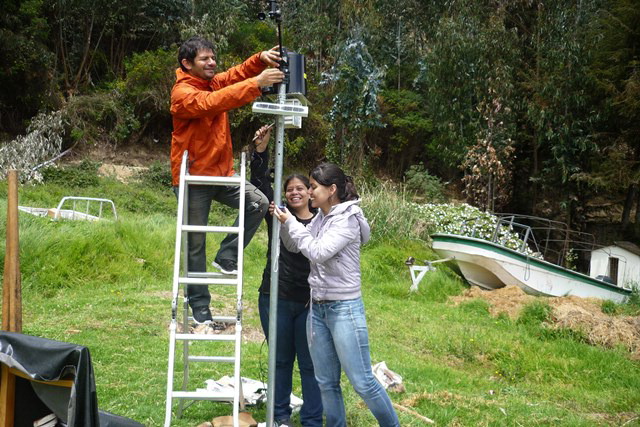Students and team members discuss the impact of climate change on natural reservoirs in Columbia (Spanish)
|
Communities in tropical regions along the Andean Cordillera in South America face an uncertain future, as mountain lakes and snow peaks exhibit receding trends and strong fluctuations associated with climatic drivers (i.e., climate change and El Niño) and local human activities. Such fluctuations are apparent in Colombia, where these changes will have direct impact on strategic ecosystems such as the Orinoco and Amazon basins and the highly populated Cauca and Magdalena River basins. Therefore, understanding how these water systems evolve in the near future is of critical importance for the communities that depend on them for their survival.
This project aimed to develop long-term monitoring of the evolution of three natural water bodies: Colombia´s two main Andean lakes (Tota and Cocha) and the floodplain wetland of Ayapel. These natural reservoirs not only represent the accumulated effect of hydrological processes in their respective basins but also serve as examples of environments from which several rural and urban communities derive their water resources and develop their economic activities.
This project gathered data about the areas of interest by contacting local, national, and international agencies for technical reports, census information, hydrologic databases, and remote sensing imagery. The information gathered, as well as gauges installed at the lakes and visits to record geographical, geophysical, and socio-economic data, was used to build models that describe the evolution of these bodies of water. Young researchers at the Master’s and doctoral levels in Colombia used the project as the foundation for developing their dissertation research.

|
| The group finishing their work on the digital station (Photo courtesy Dr. Cañón) |
The team’s findings showed significant relationships between variables such as
temperature, precipitation and levels in the wetlands and temperatures of the Atlantic and Pacific oceans. Researchers ran models to determine the moisture sources on the Colombian Andean region where the three lakes are located and highlighted the importance of moisture fluxes from the Atlantic, the Amazon, the Orinoco.
The researchers developed mathematical models to simulate the availability and quality of water of these wetlands under different climate change scenarios (i.e., higher temperatures with lower/higher precipitations) and human interventions (i.e., farming, fishing, tourism, industry, and water supply systems) for a time horizon of 50 years. Each wetland under study reflected
Each wetland under study told a different story. La Cocha (Nariño), the second
largest mountain lake in the country, has relatively more protected environmental
conditions within the international Ramsar wetland convention, serving as a reference case for interpreting changes that can be expected due to climate variability. The Tota Lake (Boyacá), the largest mountain lake in Colombia, both water quality and levels were projected to be significantly impacted as a result of withdrawals. In Ayapel Cienaga (Cordoba), water levels faced an unusual challenge due to heavy alterations suffered by the failure of a dam on the Cauca River in 2010. Overall, the study concluded that the three wetlands could survive in the conditions raised by the critical scenarios of higher temperatures and lower rainfall beyond 2050, but they would be dependent on water resources management and on decisions taken by local communities related to agricultural and other livelihood activities.
The project contributed to the professional and research development of one undergraduate, three Master’s students, and a doctoral student, and several student team members received grants for their work and future research in this area. The team participated in 11 local workshops to disseminate the results of the research and gain insight about specific aspects of each site to understand next steps. The PI and his colleagues also presented their results through academic talks on the national level and two Fall Meetings of the American Geophysical Union.
Two graduate courses were designed and offered by the PI at Universidad de Antioquia as a result of the PEER project: Statistical Methods in Time Series Analysis and Ecohydrology. In addition, three telemetric hydrological stations were built and installed by the project in each of the wetlands. The long-term aim is to keep the information about these three lakes updated and eventually incorporate other wetlands to the database.
PublicationsS.G.A. Lantua, H. Hooghiemstra, M. Vuille, H. Behling, J.F. Carson, W.D. Gosling, I. Hoyos, M.P. Ledru, E. Montoya, F. Mayle, A. Maldonado, V. Rull, M.S. Tonello, B.S. Whitney, and C. González-Arango. 2015. Climate variability and human impact on the environment in South America during the last 2000 years: synthesis and perspectives.
Climate of the Past Discussions 11: 3475-3565.
https://doi.org/10.5194/cpd-11-3475-2015 Ana Milena Plata Fajardo, Julio Cañón, and Raffaele Lafortezza. 2015. The value of rural landscape in Aquitania (Colombia): application of spatial hedonic models in real estate analysis.
Cuadernos de Desarrollo Rural 12(76): 155-179.
http://dx.doi.org/10.11144/Javeriana.cdr12-76.vrla J.F. Salazar, I. Hoyos, J.C. Villegas, and G. Poveda. 2014. Amazon deforestation effects on mean and extreme riverflows: insights from ecohydrological scaling. Presented at the AGU Fall Meeting, December 2014, San Francisco, California.
http://dx.doi.org/10.13140/2.1.1170.8488




